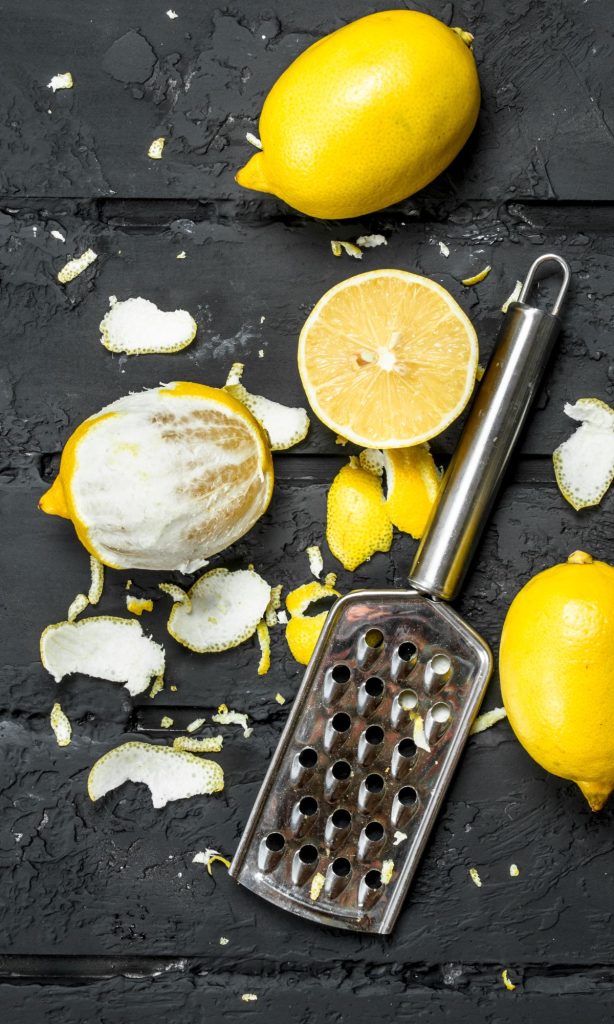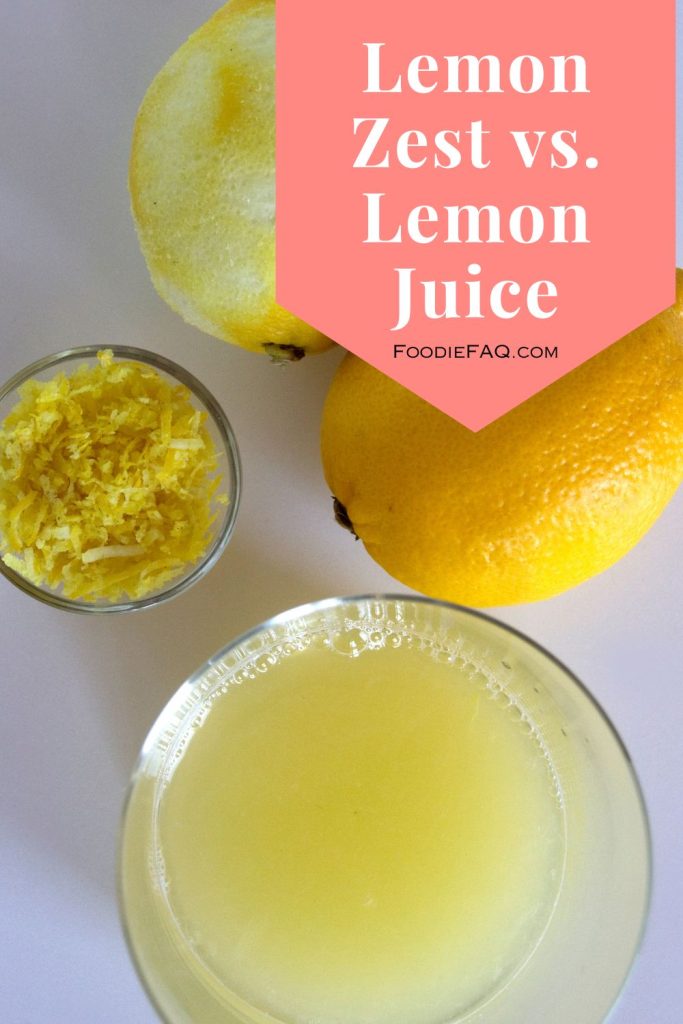So learning the difference between lemon zest and lemon juice is important. It can be tempting to interchange them when cooking but that isn’t advised. Even though they both come from the same lemon they do taste different and do serve different purposes.
Let’s get into it.

All About Lemon Zest
So, what’s the deal with lemon zest? It’s the outermost layer of the lemon peel, the part that’s bursting with bright color and packed with essential oils and fragrances that give the lemon its distinct flavor and aroma.
When you grate that zest, avoiding the slightly bitter white pith beneath, you’re unlocking a world of flavor possibilities.
I want to stress this point as best as I can because that white pith is a bit bitter. It is inevitable that you will get a bit of it when zesting and that is fine but try to avoid getting too much of it. Don’t worry though, the pith isn’t harmful. It just tastes bitter.
Now, I know that test kitchens have said that the pith of lemon is only slightly bitter but to me it is really quite bitter. Taste for yourself and let me know.
It’s a game-changer in baked goods, sauces, and marinades, infusing them with a citrusy punch. I think it is nice on top of a sorbet as a garnish.
All About Lemon Juice
Moving on to lemon juice – it’s the essence of the fruit, squeezed out to bring a zesty zing to your dishes. This liquid is all about its sour and acidic nature, adding that unmistakable tang to your culinary creations.
Think about it – lemon juice is everywhere, from marinades and dressings to that refreshing glass of lemonade. It’s like a little ray of sunshine, brightening everything it touches.
I didn’t always use it that much in cooking but now it has become so common that I have several different juicers in the kitchen. For me it all started with those box meal kits like HomeChef.
Hot Tip: A little bit of lemon juice goes a long ways when cooking.
Zest vs. Juice: What’s the Difference?
So, zest and juice – they’re both lemon, but they’re like two artists with different styles. Zest is all about the aroma and flavor, a subtle yet impactful presence. Juice, however, is the bold one, bringing sourness and acidity to the table.
The zest is the outer cheerleader, and the juice is the inner strength of the lemon. Understanding this distinction is key to mastering your lemony recipes.
The way that I tend to think about it is that zest is a zing of flavor that is bright but not overpowering. Lemon juice is strong and acidic and carries a punch of flavor.

Ways To Use Lemon Zest and Juice
When it comes to cooking and baking, lemon zest and juice are like your best kitchen buddies. Zest brings a bright, tangy twist to your cakes, cookies, and savory dishes.
It’s like adding a sprinkle of sunshine. And lemon juice? It’s your go-to for balancing flavors, from adding a kick to your pancakes to being the secret ingredient in your salad dressings. These two can elevate a simple dish to something extraordinary.
Lemon Zest Ideas:
- Enhance Baked Goods: Add zest to cookies, cakes, and bread for a citrusy twist.
- Brighten Up Salads: Sprinkle zest over green salads for a refreshing flavor.
- Flavor Boost for Marinades: Incorporate into marinades for chicken, fish, or vegetables.
- Zesty Pasta: Mix into pasta sauces or sprinkle over finished pasta dishes.
- Homemade Lemon Sugar: Mix with sugar to create lemon-infused sugar for tea or baking.
Lemon Juice Ideas:
- Fresh Lemonade: Use as the base for homemade lemonade or other citrusy beverages.
- Dressings and Vinaigrettes: Add to salad dressings for a tangy flavor.
- Enhance Fruit Flavors: Sprinkle over fresh fruit to enhance flavor and prevent browning.
- Seafood Complement: Squeeze over grilled or baked fish for a zesty finish.
- Brighten Soups and Stews: A splash of lemon juice can add depth and brightness to soups and stews.
Tips On Storing Lemon Zest And Lemon Juice
Step-by-Step Guide to Storing Lemon Zest:
- Remove Zest from Lemon: Carefully zest your lemon, ensuring to avoid the bitter white pith.
- Store in Airtight Container: Place the lemon zest in an airtight container.
- Refrigerate or Freeze: For short-term use, store the container in the refrigerator. For long-term storage, freeze the zest. It can be kept frozen for up to 6 months.
Step-by-Step Guide to Storing Lemon Juice:
- Prepare the Lemon: Before juicing, roll the lemon firmly on your countertop. This helps break down the membranes inside, yielding more juice.
- Juice the Lemon: Cut the lemon in half and juice it using a juicer, reamer, or simply by squeezing with your hands.
- Store in Airtight Container: Transfer the lemon juice to an airtight container.
- Refrigerate or Freeze: Keep the container in the refrigerator if you plan to use the juice within a few days. For longer storage, pour the juice into an ice cube tray and freeze. Once frozen, transfer the cubes to a freezer-safe bag or container. Frozen lemon juice can be stored for up to 6 months.
These steps will ensure that your lemon zest and juice stay fresh and ready for your next culinary adventure!
FAQ
How Much Zest Can You Really Get from One Lemon?
Ever wonder just how much zest you can coax out of a single lemon? Well, in my kitchen adventures, I’ve found that a typical lemon generously offers about 1 tablespoon of zest. It’s a handy bit of trivia, especially when you’re eyeballing ingredients for that lemony recipe you’re itching to try.
Zest vs. Peel: What’s the Real Scoop?
Alright, let’s clear up some citrus confusion: lemon zest and lemon peel aren’t quite the same thing. Zest is that colorful, fragrant outer layer that’s all about flavor without the bitterness.
The peel? That includes the zest and the white pith – and trust me, that pith can be a real party pooper with its bitterness. So, zest is what you want when you’re after that pure, unadulterated lemony goodness.
No Zest? No Problem!
So, you’re mid-recipe and realize you’re out of lemon zest – we’ve all been there, right? Don’t sweat it. Lemon extract or juice can jump in as a backup.
They bring their own unique vibe to the table – the extract packs a punch with its intensity, while the juice adds a milder, tangy twist. It’s all about playing with flavors to get that perfect balance in your muffins.
Why Lemon Zest is Your Baking Secret Weapon
Let me tell you, lemon zest is like a secret weapon in the baking world. It’s not just about adding flavor; it’s about bringing your baked goodies to life with that zesty, citrusy spark. It’s the difference between ‘just okay’ and ‘wow, what’s in this?’ in your cakes, cookies, and pastries. A sprinkle of zest, and you’re practically a kitchen magician.
Zesting a Lemon: A Quick How-To
If you’re diving into the world of zesting, here’s a quick guide: grab your zester or a fine grater and gently work around the lemon, targeting that sunny yellow part. The trick is to avoid the white pith lurking beneath – it’s a flavor downer with its bitterness. A good zest technique is like capturing a bit of citrus sunshine without any cloudy bitterness – perfect for all kinds of dishes.
Conclusion
And there you have it – a deeper look into the world of lemon zest and lemon juice. Armed with this knowledge, you’re all set to bring a burst of citrus magic to your kitchen. Happy cooking, and let those lemons shine!

